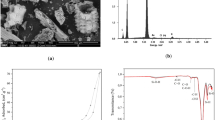Abstract
Metal cations and organic pollutants mostly co-exist in the natural environment. However, their interactions in adsorption processes have yet to be adequately addressed. In the current study, the effect of inorganic cations with different charges (Ag+, Zn2+, and Al3+) on the adsorption and desorption of 2,4,6-trichlorophenol (TCP) onto and from processed ash derived from wheat (Triticum aestivum L.) straw was investigated. The adsorption and desorption of TCP were both nonlinear; the isotherm and kinetics curves fitted well using the Freundlich equation and a pseudo-second-order model, respectively. The presence of Ag+ promoted TCP adsorption, while Zn2+ and Al3+ reduced TCP adsorption onto ash. The desorption of TCP from ash showed obvious hysteresis, and the presence of Ag+, Zn2+, and Al3+ caused the desorption to be less hysteretic. The suppression of TCP adsorption by Zn2+ and Al3+ was ascribed to the partial overlapping of adsorption groups between TCP and metal ions. Al3+ had a stronger inhibition effect than that of Zn2+ due to its higher binding capacity and larger hydrated ionic radius than those of Zn2+. Enhanced adsorption of TCP onto ash by Ag+ was ascribed to its ability to reduce the competitive adsorption of water molecules on ash surface by replacing the original ions, such as Na+ and Ca2+, and compressing the hydrated ionic radius of these metal ions. In addition, Ag+ was able to bind with the aromatic organic compounds containing π-electrons, which resulted in a further increase of TCP adsorption by ash.





Similar content being viewed by others
References
Barriuso E, Laird DA, Koskinen WC, Dowdy RH (1994) Atrazine desorption from smectites. Soil Sci Soc Am J 58:1632–1638
Benguella B, Benaissa H (2002) Cadmium removal from aqueous solutions by chitin: kinetic and equilibrium studies. Water Res 36:2463–2474
Cea M, Seaman JC, Jara AA, Mora ML, Diez MC (2005) Describing chlorophenol sorption on variable-charge soil using the triple-layer model. J Colloid Interface Sci 292:171–178
Chaliha S, Bhattacharyya KG (2008) Catalytic wet oxidation of 2-chlorophenol, 2,4-dichlorophenol and 2,4,6-trichlorophenol in water with Mn(II)–MCM41. Chem Eng J 139:575–588
Chen JY, Zhu DQ, Sun C (2007) Effect of heavy metals on the sorption of hydrophobic organic compounds to wood charcoal. Environ Sci Technol 41:2536–2541
Chen GC, Shan XQ, Wang YS, Wen B, Pei ZG, Xie YN, Liu T, Pignatello JJ (2009) Adsorption of 2,4,6-trichlorophenol onto multi-walled carbon nanotubes as affected by Cu (II). Water Res 43:2409–2418
Chun Y, Sheng G, Chiou CT, Xing B (2004) Compositions and sorptive properties of crop residue-derived chars. Environ Sci Technol 38:4649–4655
Daughney CJ, Fein JB (1997) Aqueous complexation of cadmium, lead, and copper by 2,4,6-trichlorophenolate and pentachlorophenolate. Geochim Cosmochim Acta 61:719–729
Dilip HL, Indra MM, Indra DM (2006) Removal of pyridine from aqueous solution by adsorption on bagasse fly ash. Ind Eng Chem Res 45:3934–3943
Ho YS, McKay G (1998) Sorption of dye from aqueous solution by pit. Chem Eng J 70:115–124
Keith LH, Telliard WA (1979) ES&T special report: priority pollutants: part I—a perspective view. Environ Sci Technol 13:416–423
Kung KHS, McBride MB (1991) Bonding of chlorophenols on iron and aluminum oxides. Environ Sci Technol 25:702–709
Mueller JG, Chapmanm PJ, Pritchard PH (1989) Creosote-contaminated sites. Their potential for bioremediation. Environ Sci Technol 23:1197–1201
Naidu R, Sumner ME, Harter RD (1998) Adsorption of heavy metals in strongly weathered soils, an overview. Environ Geochem Health 20:5–9
Seco-Reigosa N, Peña-Rodríguez S, Nóvoa-Muñoz JC, Arias-Estévez M, Fernández-Sanjurjo MJ, Álvarez-Rodríguez E, Núñez-Delgado A (2013) Arsenic, chromium and mercury removal using mussel shell ash or a sludge/ashes waste mixture. Environ Sci Pollut Res 20(4):2670–2678
Shah B, Mistry C, Shah A (2013) Seizure modeling of Pb (II) and Cd (II) from aqueous solution by chemically modified sugarcane bagasse fly ash: isotherms, kinetics, and column study. Environ Sci Pollut Res 20(4):2193–2209
Sprovieri M, Feo ML, Prevedello L, Manta DS, Sammartino S, Tamburrino S, Marsella E (2007) Heavy metals, polycyclic aromatic hydrocarbons and polychlorinated biphenyls in surface sediments of the Naples harbor (southern Italy). Chemosphere 67:998–1009
Srivastava VC, Swamy MM, Mall ID, Prasad B, Mishra IM (2005) Adsorptive removal of phenol by bagasse fly ash and activated carbon: Equilibrium, kinetics and thermodynamics. Colloids Surf A 272:89–104
Toth J, Milham PJ, Kaldor CJ (1999) Decreased phytotoxicity of diuron applied over ash of recently burned kangaroo grass. Plant Prot Q 14:151–154
Wang XP, Shan XQ, Luo L, Zhang SZ, Wen B (2005) Sorption of 2,4,6-trichlorophenol in model humic acid-clay systems. J Agric Food Chem 53:3548–3555
Wang YS, Feng MH, Shan XQ, Chen GC, Pei ZG, Wen B, Liu T, Xie YN, Owens G (2009) Effects of copper, lead and cadmium on the sorption of 2,4,6-trichlorophenol onto and desorption from wheat ash and two humic acids. Environ Sci Technol 43:5726–5731
Wang YS, Pei ZG, Shan XQ, Chen GC, Zheng LR, Zhang J, Xie YN (2011) Effects of metal cations on sorption–desorption of p-nitrophenol onto wheat ash. J Environ Sci 23(1):112–118
Wightman P, Fein JB (1999) Experimental study of 2,4,6-trichlorophenol and pentachlorophenol solubilities in aqueous solutions: derivation of a speciation-based chlorophenol solubility model. Appl Geochem 14:319–331
Yang YN, Sheng GY (2003) Enhanced pesticide sorption by soils containing particulate matter from crop residue burns. Environ Sci Technol 37:3635–3639
Zhou WM, Fu DQ, Sun ZG (1991) Determination of black list of China's priority pollutants in water. Res Environ Sci 4:912–915
Acknowledgements
This work was funded by the National Natural Science Foundation of China (grant numbers: 21207157, 41071308, and 21277159) and the Research Institute of Subtropical Forestry, Chinese Academy of Forestry (RISF 2013001).
Author information
Authors and Affiliations
Corresponding author
Additional information
Responsible editor: Philippe Garrigues
Rights and permissions
About this article
Cite this article
Chen, G., Wang, Y. & Pei, Z. Adsorption and desorption of 2,4,6-trichlorophenol onto and from ash as affected by Ag+, Zn2+, and Al3+ . Environ Sci Pollut Res 21, 2002–2008 (2014). https://doi.org/10.1007/s11356-013-2122-y
Received:
Accepted:
Published:
Issue Date:
DOI: https://doi.org/10.1007/s11356-013-2122-y




